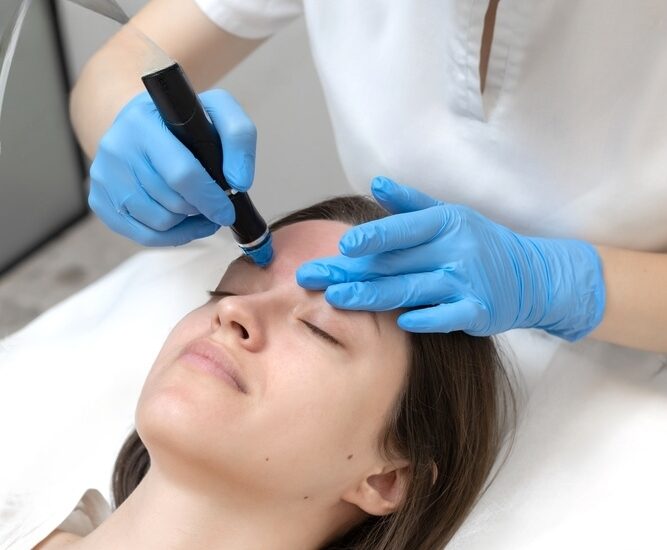The principle of PRP Therapy is to use the body’s own resources, making it a very natural approach. The PRP filler treatment uses the same principle for purifying blood plasma. A sample of the patient’s own blood is taken, which is then concentrated and purified in a special treatment to achieve a high density of platelets within a gel-like plasma solution.
This is then injected into the treatment area using a fine needle where the platelets trigger the production of naturally volumising collagen and general cell renewal.
Injecting the PRP is the key difference with PRP fillers. Many practitioners simply ‘wash’ it over prepared skin, but with PRP fillers, Dr Kubicka injects the plasma into the deeper layers of the skin, using a very fine needle to precisely target the areas where replenishing volume will work to smooth out lines and wrinkles.

Overview of the PRP Treatment
PRP Facial Rejuvenation takes about an hour to complete. A topical numbing cream may be applied 1 hour before the treatment to the treatment area to minimize discomfort during the procedure. Next, 1-4 vials of blood are drawn and centrifuged to separate out a layer of concentrated plasma rich cells, platelets and growth factors. This layer is then extracted and injected into the skin using very fine needles. Patients typically experience mild stinging during the procedure. ProNox (laughing gas) may be used to further minimize discomfort during the injection process for an additional cost. Injecting PRP directly into the tissue allows your body to absorb and fully utilize all the benefits of your extracted platelet rich plasma.
What is platelet-rich plasma?
Platelet-rich plasma consists of two elements: plasma, or the liquid portion of blood, and platelets, a type of blood cell that plays an important role in healing throughout the body. Platelets are well-known for their clotting abilities, but they also contain growth factors that can trigger cell reproduction and stimulate tissue regeneration or healing in the treated area. Platelet-rich plasma is simply blood that contains more platelets than normal.
To create platelet-rich plasma, clinicians take a blood sample from the patient and place it into a device called a centrifuge that rapidly spins the sample, separating out the other components of the blood from the platelets and concentrating them within the plasma.
Benefits of PRP Fillers
- Natural looking results – no change in facial expressions
- Long-lasting results – regenerating your body’s own tissues
- Stimulates natural hyaluronic acid – an alternative to normal dermal fillers
- Improves hydration
- Reduced wrinkles – filler effect directly tackles facial lines
- More luminous skin – PRGF®-Endoret® treatment leads to brighter skin tone
What is a PRP injection?
After creating platelet-rich plasma from a patient’s blood sample, that solution is injected into the target area, such as an injured knee or a tendon. In some cases, the clinician may use ultrasound to guide the injection. The idea is to increase the concentration of specific bioproteins or hormones, called growth factors, in a specific area to accelerate the healing process.
The mechanism behind PRP injections is not completely understood. Studies show that the increased concentration of growth factors in platelet-rich plasma may stimulate or speed up the healing process, shortening healing time for injuries, decreasing pain and even encouraging hair growth.
PRP Therapy Risks and Side Effects
A PRP injection is a low-risk procedure and does not usually cause major side effects. The procedure involves a blood draw, so you should make sure you are hydrated and have eaten beforehand to prevent feeling lightheaded. After the procedure, you may experience some soreness and bruising at the injection site.
Because PRP injections are made up of your own cells and plasma, the risk of an allergic reaction is much lower than with other injectable medications like corticosteroids. Less common risks of PRP injections include:
- Bleeding
- Tissue damage
- Infection
- Nerve injuries
Recovery
PRP Facial Rejuvenation is one of the lowest risk treatments because the process involves injecting a substance sourced from your own body. Mild injection site bruising, swelling or redness can occur but usually resolves after 3-7 days following the procedure and may be safely concealed with make-up shortly after the treatment. Other risks include infection and pain at injection sites. It is recommended that patients start taking Arnica, a homeopathic medication that naturally decreases bruising and swelling following procedures.
Results
PRP facial rejuvenation naturally stimulates your body’s own collagen production, and it takes about three months for maximum collagen regeneration to occur. Most patients notice an improvement in their skin texture in the first month after the treatment. It is recommended to have 2-3 treatments spaced at 6- 8 week intervals. The results of PRP rejuvenation are long term with most patients receiving touch up treatments at one year to further stimulate collagen production and continued facial rejuvenation. For more immediate improvement, we can combine the benefits of the PRP facial rejuvenation with Botox, fillers, microneedling, and laser skin resurfacing.
Precare instructions
- Do Not take Aspirin
- AVOID ALCOHOLIC
- Diet before Procedure
- HYDRATE: You should drink at least 8 glasses of water 24 hours before your treatment and at least 12 ounces of water the morning of your treatment
- Stopping the use of blood thinners, such as aspirin, as recommended by your practitioner
Book Your Appointment With Us!

Understanding Acne: Causes, Treatments, and Prevention
September 24, 2024

Summer Skincare Tips: How to Beat the Heat
September 24, 2024

Hydrafacial for Acne-Prone Skin
September 24, 2024

Hair Transplant Techniques: FUE vs. FUT Explained
September 24, 2024

Understanding Alopecia: Types, Causes, and Treatment Options
September 24, 2024

Hydrafacial: The Ultimate Treatment for Healthy, Glowing Skin
September 24, 2024
The Importance of Regular Skin Check-Ups: Why Dr. Abbas Shah Recommends Them
September 24, 2024

Acne Treatment
September 24, 2024

Hydra Facial
September 24, 2024

Micro Hair Transplant
September 24, 2024

Alopecia
September 24, 2024

PRP Therapy
September 23, 2024

Botox
September 22, 2024
